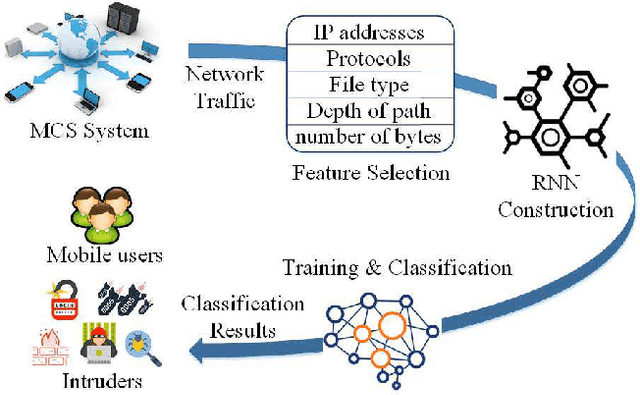Donghua Jiang
Secure Mobile Crowdsensing with Deep Learning
Jan 23, 2018



Abstract:In order to stimulate secure sensing for Internet of Things (IoT) applications such as healthcare and traffic monitoring, mobile crowdsensing (MCS) systems have to address security threats, such as jamming, spoofing and faked sensing attacks, during both the sensing and the information exchange processes in large-scale dynamic and heterogenous networks. In this article, we investigate secure mobile crowdsensing and present how to use deep learning (DL) methods such as stacked autoencoder (SAE), deep neural network (DNN), and convolutional neural network (CNN) to improve the MCS security approaches including authentication, privacy protection, faked sensing countermeasures, intrusion detection and anti-jamming transmissions in MCS. We discuss the performance gain of these DL-based approaches compared with traditional security schemes and identify the challenges that need to be addressed to implement them in practical MCS systems.
Two-dimensional Anti-jamming Mobile Communication Based on Reinforcement Learning
Dec 19, 2017



Abstract:By using smart radio devices, a jammer can dynamically change its jamming policy based on opposing security mechanisms; it can even induce the mobile device to enter a specific communication mode and then launch the jamming policy accordingly. On the other hand, mobile devices can exploit spread spectrum and user mobility to address both jamming and interference. In this paper, a two-dimensional anti-jamming mobile communication scheme is proposed in which a mobile device leaves a heavily jammed/interfered-with frequency or area. It is shown that, by applying reinforcement learning techniques, a mobile device can achieve an optimal communication policy without the need to know the jamming and interference model and the radio channel model in a dynamic game framework. More specifically, a hotbooting deep Q-network based two-dimensional mobile communication scheme is proposed that exploits experiences in similar scenarios to reduce the exploration time at the beginning of the game, and applies deep convolutional neural network and macro-action techniques to accelerate the learning speed in dynamic situations. Several real-world scenarios are simulated to evaluate the proposed method. These simulation results show that our proposed scheme can improve both the signal-to-interference-plus-noise ratio of the signals and the utility of the mobile devices against cooperative jamming compared with benchmark schemes.
 Add to Chrome
Add to Chrome Add to Firefox
Add to Firefox Add to Edge
Add to Edge